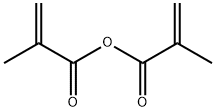메타 크릴 산 무수물 C화학적 특성, 용도, 생산
개요
Methacrylic anhydride is a reactive monomer used primarily as a monomer in the preparation of polymers, particularly poly(methacrylic acid) and its copolymers. The reaction mechanism involves the formation of covalent bonds between methacrylic acid and acetic anhydride molecules, resulting in the formation of a novel compound. The newly formed compound then undergoes a series of reactions including hydrolysis and polymerisation. Methacrylic anhydride produces polymers with good chemical and thermal stability, which are used in a wide range of applications in various industries such as bio-renewable resins, pH-sensitive hydrogels, thermoset plastics, coatings, adhesives and plastics.
화학적 성질
Methacrylic anhydride is a colorless transparent liquid which reacts with water exothermically. It can also react with hydroxyl- and amino-groups present in some organic compounds leading to covalent attachment of methacryloyl moieties.
용도
Methacrylic anhydride is a reactive monomer used for the preparation of different type of monomers under mild reaction conditions. It finds applications in light-curing coatings, cross-linked materials like synthetic resin. It acts as an intermediate for the preparation of fibers and resins.
제조 방법
To synthesize Methacrylic anhydride, sodium methacrylate (1 mol), propionyl chloride (3 mol), and a polymerization inhibitor (0.1 mol) were added to a reaction kettle. The mixture was heated to 90-100 ℃ and refluxed for 8 hours. Methacrylic anhydride was then obtained by distilling and collecting fractions at 100-105 ℃. The yield of the product was 98.33%.
일반 설명
Liquid.
공기와 물의 반응
Reacts exothermically with water to form methacrylic acid.
반응 프로필
Methacrylic anhydride reacts exothermically with water. The reactions are sometimes slow, but can become violent when local heating accelerates their rate. Acids accelerate the reaction with water. Incompatible with acids, strong oxidizing agents, alcohols, amines, and bases.
화재위험
(Non-Specific -- Methacrylic Acid) Methacrylic anhydride may burn but may not ignite readily. Flammable/ poisonous gases may accumulate in tanks and hopper cars. Some of these materials may ignite combustibles (wood, paper, oil, etc.).
Synthesis
In a 300 ml four-necked flask equipped with a stirrer and a thermometer, pure air was charged with 148.6 mL of acetone, 49.5 g (0.46 mol) of potassium methacrylate, 49.5 mg of 4-methoxyphenol, and 49.5 mg of phenothiazine under an ice bath. It was stirred and dispersed. 25.0 g (0.22 mol) of MsCl was added dropwise thereto over 30 minutes. Then, the mixture was stirred under an ice bath, and when it was confirmed that the exotherm had subsided, the outside temperature was set to 25 ° C., and the reaction was followed by GC while aging for 1 hour. As a result, it was confirmed that MsCl had disappeared. The conversion rate of the crude body was 99.0%. After completion of the reaction, the mixture was filtered using a filter paper, washed with 100 mL of acetone three times, and then acetone was distilled off under reduced pressure to obtain 27.8 g of crude methacrylic anhydride (crude yield 101.0% with respect to MsCl, GC). Purity 98.0%) was obtained. Subsequently, the crude product was distilled under reduced pressure under pure air to obtain 26.1 g of methacrylic anhydride (b.p.53 ° C. (O.4 kPa), yield 94.8% with respect to MsCl, GC purity 99.6%).
Purification Methods
Distil the anhydride at 2mm pressure, immediately before use, in the presence of hydroquinone. [Beilstein 2 IV 1537.]
메타 크릴 산 무수물 준비 용품 및 원자재
원자재
준비 용품








